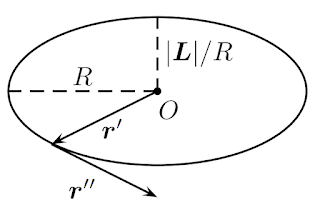Monopole and dipole dynamics on Riemann surfaces
We'll look at the dynamics of monopoles and dipoles on a Riemann surface. The presentation will build upon the papers Vortex pairs and dipoles on closed surfaces and Vortex motion and geometric function theory: the role of connections by Björn Gustafsson.
Notation: A prime denotes differentiation with respect to $z$. If the function that is differentiated is holomorphic, this is the holomorphic derivative: $f'=df/dz$. If the function is not holomorphic, this is the Wirtinger derivative: $f'=\partial f/\partial z=(1/2)(\partial f/\partial x-i\partial f/\partial y)$.
Setup
On a closed Riemann surface $M$ with genus $g\geq 0$ and conformal metric $ds=\lambda(z)|dz|$ we place $n$ monopoles at points $z_1,\ldots,z_n$ and $m$ dipoles at points $w_1,\ldots,w_{m}$. To each monopole we associate a complex strength $\Gamma_k$. For real positive strength, the monopole is a source, for real negative strength, it is a sink and for imaginary strength it is a vortex. We require that the strengths sum to zero, $\sum_k\Gamma_k=0$. To each dipole we associate a complex moment $\delta w_k$ that gives the orientation and strength of the dipole. The dipole moment value is coordinate dependent. If $\tilde{z}=\varphi(z)$ is a coordinate transformation, the dipole moment transforms as $\delta\tilde{w_k}=\varphi'(w_k)\delta w_k$. The coordinate independent strength of a dipole is $\lambda(w_k)|\delta w_k|$.
The set of monopoles as two-point dipoles
Since the strengths of the monopoles sum to zero, we represent them with two-point dipoles instead. To the set of $n$ monopoles placed at points $\{z_k\}_{k=1}^n$ we have $n(n-1)/2$ two-point dipoles placed at point pairs $\{z_k,z_l\}_{k\lt l}$ where $z_k$ is the position of a unit source and $z_l$ is the position of a unit sink. We let the strengths of the two-point dipoles be \[ \Gamma_{kl} = \frac{\Gamma_k(\Gamma_k-\Gamma_l)}{\sum_{j=k+1}^n(\Gamma_k-\Gamma_j)} \] This is the unique assignment such that $\Gamma_{jk}+\Gamma_{kl}-\Gamma_{lj}=0$ for all triples $\{j,k,l\}_{j\lt k\lt l}$. A unit two-point dipole with source at $a_+$ and sink at $a_-$ has a unique potential $G(z,a_+,a_-)$ that is circulation free and holomorphic away from $a_+$ and $a_-$ and is the solution to \[ \Delta G(z,a_+,a_-) = \delta_{a_+}-\delta_{a_-}, \] where $\Delta=-d*d$ is the Laplace operator taking zero-forms to two-forms and $\delta_a$ is the Dirac two-form defined as $\int_M\phi\delta_a=\phi(a)$ for any function $\phi(z)$.One-point dipoles
The function \[ D(z,a)\delta a=\lim_{h\rightarrow 0}\frac{G(z,a+h,a-h)}{2h}\delta a \] is the potential of a one-point dipole at $a$ with moment $\delta a$ since \begin{align} \Delta D(z,a) &= \Delta\lim_{h\rightarrow 0}\frac{G(z,a+h,a-h)}{2h} = \lim_{h\rightarrow 0}\frac{\Delta G(z,a+h,a-h)}{2h} = \\ &= \lim_{h\rightarrow 0}\frac{\delta_{a+h}-\delta_{a-h}}{2h} = \frac{\partial\delta_a}{\partial a}. \end{align}Renormalisation of the two-point dipole potential
Let $p_{\text{re}}(z)+\log |dz| =\log(\lambda(z)|dz|)$ be the logarithmic metric. The term $p_{\text{re}}(z)$ is a real 0-connection. At a point $a$ we can approximate the logarithmic metric with a complex logarithmic form \[ p(z)+\log dz = \sum_{k=0}^\infty\frac{p_{\text{re}}^{(k)}(a)}{k!}(z-a)^k + \log dz, \] where $p_{\text{re}}^{(k)}=\partial^kp_{\text{re}}/\partial z^k$ is the iterated Wirtinger derivative and $p(z)$ is then a holomorphic 0-connection. The logarithmic form can be exponentiated to give a holomorphic one-form $\lambda_{\text{hol}}(z)dz=e^{p(z)}dz$. The one-form is the differential of the function \[ \Lambda(z,a)=\int_a^z\lambda_{\text{hol}}(w)dw \] The function $F(z,a)=(-1/2\pi)\log\Lambda(z,a)$ is the local potential of a monopole since \[ \Delta F(z,a) = -\Delta\frac{1}{2\pi}\log\Lambda(z,a) = -\Delta\frac{1}{2\pi}\left(\log (z-a)+O(1)\right) = -\frac{1}{2\pi}\Delta\log (z-a) = \delta_a \] The monopole potential has expansion \begin{align} F(z,a) &= -\frac{1}{2\pi}\log\Lambda(z,a)= \\ &= -\frac{1}{2\pi}\log\left(\lambda(a)(z-a)+\frac{\lambda'(a)}{2}(z-a)^2+\frac{\lambda''(a)}{6}(z-a)^3+O\left((z-a)^4\right)\right)=\\ &= -\frac{1}{2\pi}\Biggl(\log(z-a)+\log\lambda(a)+ \notag\\ &\hspace{2cm}+\log\left(1+\frac{1}{2}\frac{\lambda'(a)}{\lambda(a)}(z-a)+\frac{1}{6}\frac{\lambda''(a)}{\lambda(a)}(z-a)^2+O\left((z-a)^3\right)\right)\Biggr)=\\ &= -\frac{1}{2\pi}\Biggl(\log(z-a)+\log\lambda(a)+\frac{1}{2}\frac{\lambda'(a)}{\lambda(a)}(z-a)+ \notag\\ &\hspace{2cm} +\frac{1}{6}\left(\frac{\lambda''(a)}{\lambda(a)}-\frac{3}{2}\left(\frac{\lambda'(a)}{\lambda(a)}\right)^2\right)(z-a)^2+O\left((z-a)^3\right)\Biggr) \end{align} The monopole potential has two differentials, the ordinary with respect to $z$, but also a differential with respect to $a$. We have the following relation between the two differentials \[ F'(z,a)dz = \frac{\Lambda_a'(z)dz}{2\pi\Lambda(z,a)} = \frac{\lambda_{\text{hol}}(z)dz}{2\pi\Lambda(z,a)} = \frac{\lambda_{\text{hol}}(a)da}{2\pi\Lambda(z,a)} = \frac{-(\partial\Lambda(z,a)/\partial a)da}{2\pi\Lambda(z,a)} = - \frac{\partial F(z,a)}{\partial a}da. \] The ordinary differential of the monopole potential has expansion \begin{align} dF(z,a) &= d\frac{1}{2\pi}\log\Lambda(z,a) = \\ &= \frac{1}{2\pi}\left(\frac{1}{z-a}+\frac{1}{2}\frac{\lambda'(a)}{\lambda(a)}+\frac{1}{3}\left(\frac{\lambda''(a)}{\lambda(a)}-\frac{3}{2}\left(\frac{\lambda'(a)}{\lambda(a)}\right)^2\right)(z-a)+O\left((z-a)^2\right)\right)dz \end{align} At the monopole points $a_+$ and $a_-$ the two-point dipole potential is singular and needs to be renormalised. We decompose it at a neighbourhood of the source $a_+$ as \[ G(z,a_+,a_-) = \frac{1}{2\pi}\log\Lambda_{a_+}(z)+H(z,a_+,a_-) \] where $H(z,a_+,a_-)$ is a holomorphic function. The differential of the potential is \[ dG(z,a_+,a_-) = \frac{1}{2\pi}\left(\frac{1}{z-a_+}+\frac{1}{2}\frac{\lambda'(a_+)}{\lambda(a_+)}+O(z-a_+)\right)dz+H'(z,a_+,a_-)dz \] The first term make up the singularity and we renormalise the differential by only keeping the regular part \[ dG_{\text{renorm}}(a_+,a_+,a_-) = H'(a_+,a_+,a_-)dz \] Since the two-point dipole potential is antisymmetrical in $a_+$ and $a_-$, $G(z,a_+,a_-)=-G(z,a_-,a_+)$, the renormalisation at the sink $a_-$ is \[ dG_{\text{renorm}}(a_-,a_+,a_-) = -H'(a_-,a_-,a_+)dz \]Renormalisation of the one-point dipole potential
The associated one-form in $a$ of a one-point dipole, $D(z,a)da$, has the decomposition at a neigbourhood of $a$ \begin{align} D(z,a)da &= \lim_{h\rightarrow 0}\frac{G(z,a+h,a-h)}{2h}da = \\ &= \lim_{h\rightarrow 0}\frac{G(z,a+h,a-h)+G(z,a+h,a-h)}{4h}da = \\ &= \lim_{h\rightarrow 0}\frac{G(z,a+h,a-h)-G(z,a-h,a+h)}{4h}da = \\ &= \lim_{h\rightarrow 0}\frac{F(z,a+h)+H(z,a+h,a-h)-F(z,a-h)-H(z,a-h,a+h)}{4h}da = \\ &= \lim_{h\rightarrow 0}\frac{F(z,a+h)-F(z,a-h)+H(z,a+h,a-h)-H(z,a-h,a+h)}{4h}da = \\ &= \frac{1}{2}\frac{\partial F(z,a)}{\partial a}da+\lim_{h\rightarrow 0}\frac{H(z,a+h,a-h)}{4h}da-\lim_{h\rightarrow 0}\frac{H(z,a-h,a+h)}{4h}da = \\ &= -\frac{1}{2}F'(z,a)dz+H_1(z,a)da, \end{align} where $H_1(z,a)=\lim_{h\rightarrow 0}H(z,a+h,a-h)/2h$. By evaluating $dz$ and $da$ on the vector fields $\delta a\partial/\partial z$ respectively $\delta a\partial/\partial a$ we get that the one-point dipole potential has the decomposition \[ D(z,a)\delta a = -\frac{1}{2}F'(z,a)\delta a+H_1(z,a)\delta a. \] The differential of the one-point dipole potential has expansion \begin{align} dD(z,a)\delta a &= d\left(-\frac{1}{2}F'(z,a)\delta a+H_1(z,a)\delta a\right) = \\ &= -\frac{1}{2}F''(z,a)\delta adz+H_1'(z,a)\delta adz = \\ &= -\frac{1}{4\pi}\left(-\frac{1}{(z-a)^2}+\frac{1}{3}\left(\frac{\lambda''(a)}{\lambda(a)}-\frac{3}{2}\left(\frac{\lambda'(a)}{\lambda(a)}\right)^2\right)+O(z-a)\right)\delta adz+H_1'(z,a)\delta adz \end{align} The first term make up the singularity and we renormalise the differential by only keeping the regular part \[ dD_{\text{renorm}}(a,a)\delta a = H_1'(a,a)\delta adz \]The flow
The flow is divergence free and irrotational outside the singularities and is described by a complex potential $\Phi$ with differential $d\Phi=d\varphi+id\psi$, where $d\varphi$ is the flow one-form and $d\psi$ is the conjugate flow one-form. Since the Riemann surface is not required to be simple connected, $\Phi$ may be multivalued. The complex potential then fullfills the continuity equation
\[ \Delta\Phi = \sum_{k=1}^{n}\Gamma_k\delta_{z_k} + \sum_{k=1}^{m}\delta w_k\frac{\partial\delta_{w_k}}{\partial w_k} \]We can decompose the flow potential $\Phi$ into
\[ \Phi(z) = \sum_{1\leq k\lt l\leq n}\Gamma_{kl}G(z,z_k,z_l)+\sum_{k=1}^m\delta w_kD(z,w_k)+U(z) \] where $U(z)$ is the holomorphic part. The holomorphic potentials on $M$ have a basis of $g$ holomorphic multivalued functions $V_1,\ldots,V_g$ and $U$ can then be expressed as $U = \sum_{k=1}^gc_kV_k$.The complex flow vector field $v(z)$ is given by
\begin{align} v(z) &= \frac{1}{\lambda(z)^2}\overline{\Phi'} = \\ &= \frac{1}{\lambda(z)^2}\left(\sum_{1\leq k\lt l\leq n}\overline{\Gamma}_{kl}\overline{G'}(z,z_k,z_l)+\sum_{k=1}^m\overline{\delta w}_k\overline{D'}(z,w_k)+\sum_{k=1}^g\overline{c}_k\overline{V_k'}(z)\right) \end{align}

Comments
Post a Comment